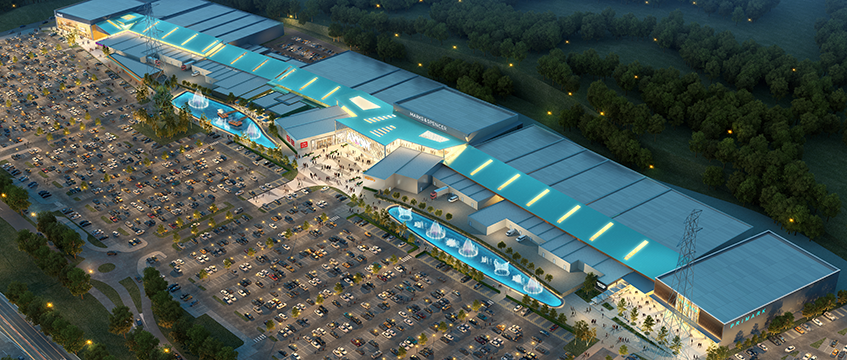With barely a day going by without a retailer either writing to landlords to reduce rents and offload space or using a Company Voluntary Arrangement to force landlords to take back unwanted square feet, should the industry be proposing development of more space or seeking alternative uses for the millions of square feet potentially being vacated?
Here, a developer planning on bringing some 600,000 sq ft of new shopping space to market and an adviser who is often tasked with filling that space, argue the reasons for and against.
 FOR
FOR
Philip Lunn, managing director, Lateral Property Group – developer of the 600,000 sq ft Axiom shopping centre in Yorkshire
“Shopping satisfies one of the most basic human needs: physical and social interaction. It is therefore a fascinating time to be a retail developer with huge ongoing structural changes in the retail market. Many commentators have tried to distil this change into a battle between online and physical.
But this is over-simplistic and ignores how shopping works at an emotional level. It also fails to address two key key issues: changes in consumer demand and polarisation of retail destinations.
We admire a California-based developer, Caruso Affiliates, which owns and operates a number of the most successful retail destinations in America. In 2014, its chief executive, Rick Caruso said: “We are part of a rebirth of bricks and mortar retail. It’s easy to get distracted by the relentless conversation of the internet versus bricks and mortar, but now more than ever what we need to do is focus on what has always been and what will always be essential to our customer – creating an experience that is magical and creating an experience that is memorable”
Those words resonated with us and we believe they contain the key ingredients of how to remain relevant.
For years, the shopping centre model was simple: Inward looking, where the retail stores ruled, dominated by the traditional anchor department store, often with an enormous but now oversized food store.
We do not believe it is a question of bravery, we believe it is about having a clear vision on the future of retail
Centres were surrounded by seas of parking, with little public realm or greenery and functional, energy inefficient, climate-controlled pedestrian malls with little sense of relationship to the communities that surrounded them.
For physical retail to thrive and survive, there has to be an acknowledgement that both shoppers and brands need more than bland boxes.
The retail destination of tomorrow won’t just be built around the retail transaction. Instead, they will be mixed-use destinations for all generations that deliver discovery, experimentation, education and entertainment where shoppers can come together and share experiences. We must acknowledge that we are no longer in the property business, we are in the hospitality business.
The Crown Estate launched Rushden Lakes in 2017. This was a major step forward, delivering a day out experience by mixing a strong retail and leisure offer with great public realm, and unique all-seasons leisure experiences within their lakes and parkland. Retailers tell us it is trading exceptionally well and it is should be seen as a barometer for the type of customer experience we all need to deliver going forwards.
We have heard people say we are brave with Axiom-Yorkshire, which is the largest out-of-town retail and leisure development in the UK since Bluewater. Having acquired the site and secured planning, we do not believe it is a question of bravery, we believe it is about having a clear vision on the future of retail.
We have the space and flexibility to draw from the best retail and leisure innovations, we are designing for the future by integrating the latest digital technology, and we will deliver flexible, flagship regional retail showcases. We also have 6.8m people – more than 10% of the UK’s population – within an hour’s drive.
We have one of only six snow domes in the UK directly adjacent, which is Yorkshire’s most visited leisure attraction. More importantly, we are designing an experience that will deliver magical and memorable experiences within our 106-acre estate through four core values: convenience, experience, excitement and delight.
The master of magical and memorable experiences is surely Walt Disney. If Disney developed a shopping destination today, what would it be like? I’d like to think his vision would be something like Axiom, delivering memorable and magical moments.
 AGAINST
AGAINST
Justin Taylor, head of EMEA retail, Cushman & Wakefield
Right now, three factors are structurally reshaping the retail market. First, there appears to be limited positive news regarding the near-term economy for the consumer. Second, there are significant societal changes under way, with people increasingly living in large urban centres, people living longer, falling levels of home ownership, and people staying single for longer. And third, there is the impact of digital, data and social media on all aspects of retail.
All of this is changing customer behaviour, which will in turn affect the future characteristics of retail. Shops are likely to be increasingly used as a place to exhibit the brand and as a marketing channel – a place with the potential to execute sales, but where that is not necessarily the primary purpose – and where brands will increasingly need to include services as well as products.
There is evidence indicating that 80%-plus of all retail sales still touch the physical store. Hence, without question, bricks-and-mortar retail will continue to be at the cornerstone of the retail market.
Retail sectors which appear to be performing the strongest are those which do not occupy the centre ground. Instead they have a compelling customer proposition based around value and fast fashion, or alternatively attract customers who are looking for a more immersive brand engagement with an aspirational or premium brand.
The question facing us is not as binary as whether we have too much or too little floor space per se. This is a complex subject which takes in layers of analysis of catchment, spending, competition, supply and demand, and obsolescence. The more important question is whether we have the ‘right’ type of floor space in the ‘right’ location, as part of the correct overall mix required to create an engaging place.
There may be more than 100 shopping centres which are at best, in limbo or, at worst, falling significantly in attractiveness and value with 20%-plus vacancy rates
It is a fact that London is under-shopped and locations such as Oxford and Edinburgh are demonstrating a clear demand for new retail floor space.
It is suggested that already in the UK, there may be more than 100 shopping centres which are at best, in limbo or, at worst, falling significantly in attractiveness and value, with 20%-plus vacancy rates.
So, at the risk of making broad generalisations, over time it may become evident that the UK has 25-30% of the “wrong” type of retail floor space in the “wrong” location.
As Daniel Hurwitz, the former chief executive of DDR, observes, “I don’t think we’re overbuilt, I think we’re under-demolished”.
It is, however, in these locations that there will be an opportunity for town centres to regenerate with an ultra-multi mix of uses, with limited amounts of retail floor space, but being places to work, play, stay, learn and eat.
This world will have “co-mingling” and the common interests of users at its heart, driven by shared experience around engagement, events, innovation, learning and education and a more integrated ecosystem than currently exists. Mono-sector retail will therefore have increasingly less relevance in many locations.











